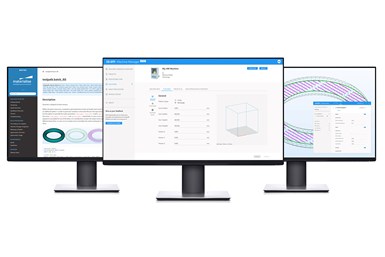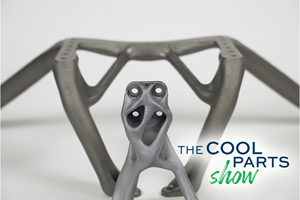Nikon SLM Solutions Works With Materialise to Interlink Metal 3D Printing Capabilities
This collaboration is designed to equip manufacturers with the right machine and the autonomy to customize their 3D printing processes as the partnership focuses on new Materialise build processors with seamless integration into CO-AM for Nikon SLM Solutions printers.
Nikon SLM Solutions and Materialise, both global providers of 3D printing technologies, have unveiled a collaborative venture to cultivate the ensuing generation of Materialise Build Processors (BPs) tailored for Nikon SLM Solutions printers, seamlessly integrating them into the Materialise CO-AM platform.
As manufacturers increasingly pivot toward metal additive manufacturing (AM) for end-use components, the companies say that the call for enhanced part quality, competitive pricing and swift production is paramount. This collaboration is poised to equip manufacturers with the right machine and the autonomy to customize their 3D printing processes.
With the advent of NXG machines, Nikon SLM Solutions offers highly productive metal 3D printers designed for high-volume manufacturing. Powered by 12 1-kW lasers, these machines boast the largest build envelope in the industry, facilitating unparalleled part sizes and quantities in a single run.
The expansive printer volume necessitates the processing of a substantial data volume, which traditionally elongates calculation times, thus impeding the workflow to initiate print jobs. Bridging the gap between data preparation and actual printing is vital to harnessing the full productivity potential.
Nikon SLM Solutions and Materialise have combined their expertise to curate the next-gen BPs and address this bottleneck, providing AM users the latitude to modify their 3D printing process as per their requirements. The novel BP is slated for release in the upcoming months for NXG and all SLM users employing Materialise software solutions.
“Working with Materialise, we have made a giant leap in developing a high-performative build processor,” says Nicolas Lemaire, product manager — software, product control and strategic partnerships at Nikon SLM Solutions. “With this next generation of build processors, our customers using Materialise software will save time during the print job setup and profit from tools to optimize their print process.”
A BP acts as a conduit, linking 3D printers with data preparation software like Materialise Magics. Post-data preparation, an extensive data volume requires processing to furnish the requisite information for the 3D printer to fabricate the parts. The forthcoming Materialise BPs expedite this phase, offering AM users the flexibility to customize process parameters to optimize application outcomes.
This milestone was achieved through the Materialise BP Software Development Kit (SDK), fostering close collaboration during development and enabling machine manufacturers to securely encapsulate their own intellectual property (IP). Nikon SLM users can experience markedly reduced calculation times, with the liberty to optimize machine parameters through the Nikon SLM Open Architecture or utilize the Materialise BP SDK to formulate parameters and create their own IP. By fine-tuning print parameters, AM users can attain the sweet spot of cost-efficiency, production speed and part quality, enabling the manufacture of intricate parts and mass production of identical or personalized products with consistent quality, reduced scrap rates and abbreviated lead times.
“Nikon SLM Solutions and Materialise share a vision of open systems that enable AM users to make optimal use of their equipment and connect it to their preferred solutions,” says Bart Van der Schueren, Materialise CTO. “We look forward to offering the next generation of BPs to Nikon SLM Solutions users and providing them access to software solutions covering the whole AM workflow.”
In conjunction with the emergent Materialise BPs, Nikon SLM Solutions users will also have direct machine connectivity to the Materialise CO-AM Software Platform via SLM.Link, Nikon SLM Solutions’ open platform communication interface. CO-AM enables users to integrate their 3D printers into existing production systems and refine the AM workflow from order inception to delivery. The software platform unveils access to auxiliary solutions from Materialise and third parties, including CO-AM partner solutions for design automation, mass customization, automated labeling and various postprocessing technologies. CO-AM empowers AM users to connect and manage technologies from diverse machine builders.
Related Content
Carnegie Mellon Helps Industry, Students Prepare for a Manufacturing Future with AM and AI
Work underway at the university’s Next Manufacturing Center and Manufacturing Futures Institute is helping industrial additive manufacturers achieve success today, while applying artificial intelligence, surrogate modeling and more to solve the problems of the future.
Read MoreHybrid Additive Manufacturing Improves Debarking Knife Tip Strength and Production Efficiency
Nicholson Manufacturing chose the Mastercam APlus specialized add-on to unlock hybrid manufacturing for making its debarker knife tips, enabling it to add durable layers to the wear surfaces of the tips to make them more resilient while also making the production process more efficient.
Read MoreSemiconductors, Tungsten, AM Affordability and More from Formnext 2024: AM Radio #56
The trade show included increased applications for the semiconductor market, machine launches and technology advances aimed at cost cutting, plenty of LFAM and more. Listen to our conversation on Formnext 2024.
Read More3D Printed "Evolved Structures" for NASA Exoplanet Balloon Mission: The Cool Parts Show #61
Generative design creates stiff, lightweight brackets for EXCITE mission monitoring planets orbiting other stars. The Cool Parts Show visits Goddard Space Flight Center.
Read MoreRead Next
Profilometry-Based Indentation Plastometry (PIP) as an Alternative to Standard Tensile Testing
UK-based Plastometrex offers a benchtop testing device utilizing PIP to quickly and easily analyze the yield strength, tensile strength and uniform elongation of samples and even printed parts. The solution is particularly useful for additive manufacturing.
Read MoreCrushable Lattices: The Lightweight Structures That Will Protect an Interplanetary Payload
NASA uses laser powder bed fusion plus chemical etching to create the lattice forms engineered to keep Mars rocks safe during a crash landing on Earth.
Read More3D Printed Polymer EOAT Increases Safety of Cobots
Contract manufacturer Anubis 3D applies polymer 3D printing processes to manufacture cobot tooling that is lightweight, smooth and safer for human interaction.
Read More





















